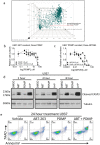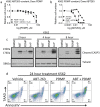Inhibition of ceramide metabolism sensitizes human leukemia cells to inhibition of BCL2-like proteins
- PMID: 23342165
- PMCID: PMC3546986
- DOI: 10.1371/journal.pone.0054525
Inhibition of ceramide metabolism sensitizes human leukemia cells to inhibition of BCL2-like proteins
Abstract
The identification of novel combinations of effective cancer drugs is required for the successful treatment of cancer patients for a number of reasons. First, many "cancer specific" therapeutics display detrimental patient side-effects and second, there are almost no examples of single agent therapeutics that lead to cures. One strategy to decrease both the effective dose of individual drugs and the potential for therapeutic resistance is to combine drugs that regulate independent pathways that converge on cell death. BCL2-like family members are key proteins that regulate apoptosis. We conducted a screen to identify drugs that could be combined with an inhibitor of anti-apoptotic BCL2-like proteins, ABT-263, to kill human leukemia cells lines. We found that the combination of D,L-threo-1-phenyl-2-decanoylamino-3-morpholino-1-propanol (PDMP) hydrochloride, an inhibitor of glucosylceramide synthase, potently synergized with ABT-263 in the killing of multiple human leukemia cell lines. Treatment of cells with PDMP and ABT-263 led to dramatic elevation of two pro-apoptotic sphingolipids, namely ceramide and sphingosine. Furthermore, treatment of cells with the sphingosine kinase inhibitor, SKi-II, also dramatically synergized with ABT-263 to kill leukemia cells and similarly increased ceramides and sphingosine. Data suggest that synergism with ABT-263 requires accumulation of ceramides and sphingosine, as AMP-deoxynojirimycin, (an inhibitor of the glycosphingolipid pathway) did not elevate ceramides or sphingosine and importantly did not sensitize cells to ABT-263 treatment. Taken together, our data suggest that combining inhibitors of anti-apoptotic BCL2-like proteins with drugs that alter the balance of bioactive sphingolipids will be a powerful combination for the treatment of human cancers.
Conflict of interest statement
Figures







References
-
- Hanahan D, Weinberg RA (2000) The hallmarks of cancer. Cell 100: 57–70. - PubMed
-
- Adams JM, Cory S (1998) The Bcl-2 protein family: arbiters of cell survival. Science 281: 1322–1326. - PubMed
-
- Tsujimoto Y (1998) Role of Bcl-2 family proteins in apoptosis: apoptosomes or mitochondria? Genes Cells 3: 697–707. - PubMed
-
- Perera MN, Lin SH, Peterson YK, Bielawska A, Szulc ZM, et al. (2012) Bax and Bcl-xL exert their regulation on different sites of the ceramide channel. Biochem J 445: 81–91. - PubMed
-
- Hannun YA, Obeid LM (2008) Principles of bioactive lipid signalling: lessons from sphingolipids. Nat Rev Mol Cell Biol 9: 139–150. - PubMed
Publication types
MeSH terms
Substances
Grants and funding
LinkOut - more resources
Full Text Sources
Other Literature Sources

